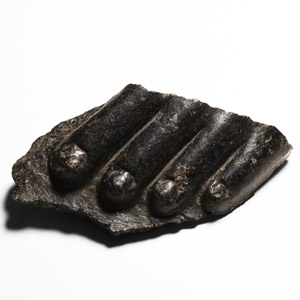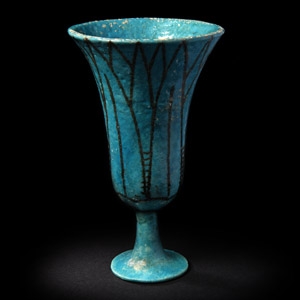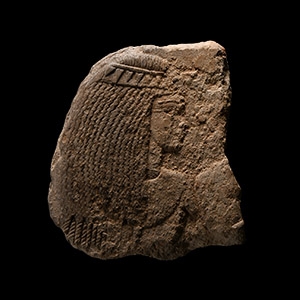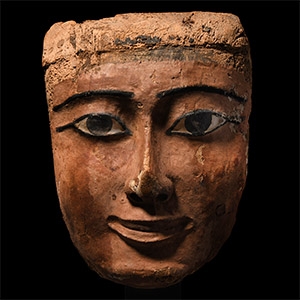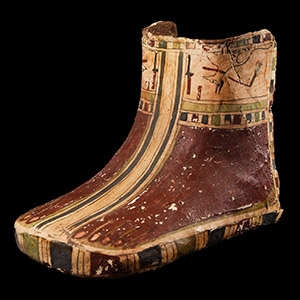Home > Auctions > 21 - 25 February 2023
Ancient Art, Antiquities, Natural History & Coins
Auction Highlights:
Supplied with small a handwritten note: 'Antiquities found in Rome, given to Henrietta Sophia Benfield by her mother'.
Henrietta Sophia Benfield (1796-1857) was the daughter of Paul Benfield and his wife, Mary Frances, daughter of Henry Swinburne (1743-1803). Property of the Berkeley collection. With Sotheby's, London, 11 December 2019, lot 182.
English private collection.
Acquired from Dr Jan Beekmans, circa 1985.
UK private collection.
Accompanied by an academic report by Egyptologist Paul Whelan.
This lot has been checked against the Interpol Database of stolen works of art and is accompanied by search certificate no.11594-198343.
Cf. The Metropolitan Museum, New York, accession number 1972.48, for a similar figure; cf. Bourriau, J., Pharaohs And Mortals, Egyptian art in the Middle Kingdom, CUP, 1988, pp.121-122, for discussion and female dwarf figures; for a detailed discussion of the three-braid hairstyle see Tooley, A.M.J., Notes on Type 1 Truncated Figurines. Part 2. Hairstyles and the Conceptual Development of Braided Forms, SAK 49, 2020, pp.243-274 and pl. 27.
This figurine belongs to a rare sub-type in a category of anthropomorphic figures produced during the late 12th-13th Dynasty. The category comprises around 200 figurines which include truncated-leg females, ‘grotesque’ human forms, and those displaying more distinct traits of achondroplasia, such as can be observed in this figurine. Very few examples of this particular sub-type are known, of which only one in the Metropolitan Museum of Art, New York provides a close parallel in terms of overall styling and form with this figurine. The purpose of this figurine is not fully understood, but other types of female representations in the large corpus of Middle Kingdom faience figurines are now considered to have embodied generative and regenerative power for their owners. This figurine shares the same distinctive three-braid hairstyle and the necklace, armlets, and girdle body adornments found on some. Body adornments of this kind also occur on wooden ‘paddle doll’ female figurines which are considered to have some connection with khener-dancers, who performed in royal, temple and funerary spheres. Since, in funeral contexts, ritual dances were often performed by dwarfs, a further connection can possibly be made between the role of khener-dancers and this figurine. The performance of such dancers in royal or funerary contexts was considered to bring the power of regeneration and potency to the recipient.
From the estate of a deceased American, acquired between 1970-1989.
with Bonham's, London, Knightsbridge, 28 October 2009, lot 23 [Part].
Accompanied by a copy of the relevant Bonhams catalogue pages.
This lot has been checked against the Interpol Database of stolen works of art and is accompanied by search certificate no.11596-198972.
From an old UK collection.
From the private collection of Alf Baxendale (1941-2016) part 2, keen Egyptologist, member of the Egyptology Society, trustee of the Amarna Trust; thence by descent.
Accompanied by an identification display card.
Accompanied by a copy of his obituary published in Horizon, The Amarna Project and Amarna Trust newsletter, Issue 18, 2017, p.21, by Barry John Kemp, CBE, FBA, Professor Emeritus of Egyptology at the University of Cambridge and directing excavations at Amarna in Egypt.
See Petrie, W.M.F., Scarabs and Cylinders with Names, London, 1917, pp.44-45, nos.36-37, for similar arrangements of Seti I’s throne name with two Maat feathers and the cartouche with legend; for a similar arrangement of the Thutmose III cartouche with legends (on a scarab from his reign) see Ben-Tor, D., The Scarab: A Reflection of Ancient Egypt, Jerusalem, 1993, p.50, no.12
Seti I's reign saw the production of many scarabs, scaraboids and plaques bearing his name as well as that of Thutmose III - who was considered a great warrior king.
Acquired from France, 2015.
English private collection.
Accompanied by a copy of the French cultural passport no.167713.
Accompanied by an academic report by Dr Alberto Maria Pollastrini.
From a Worcester deceased estate.
Property of a Cambridgeshire gentleman.
Accompanied by an academic report by Egyptologist Paul Whelan.
See Janes, G., The Shabti Collections 6: A Selection from World Museum, Liverpool, Cheshire, 2016, pp.270-271, nos.125a-b, for an overseer and worker shabti for Pa-di-Khonsu-iy.
As a wab-priest, Pa-di-Khonsu-iy would have assisted a higher-ranking hem-priest with the general maintenance and ritual activities in a temple, likely located either in Thebes in Upper Egypt or Tanis in the Delta.
Acquired from Dr Jan Beekmans, circa 1982.
UK private collection.
Accompanied by an academic report by Egyptologist Paul Whelan.
This lot has been checked against the Interpol Database of stolen works of art and is accompanied by search certificate no.11599-198342.
Cf. The British Museum, museum number EA4801 'Blue glazed composition (faience) drinking-cup, in the form of a stemmed lotus flower', for similar; cf. The Metropolitan Museum, accession number 26.7.972, for similar; Walters Art Gallery, inventory no.48.416, for similar.
It is thought that blue lotus chalices served cultic or votive roles in temples or in offering rituals to the dead, and the white lotus versions were used as drinking vessels. Called Seshen by the ancient Egyptians, the blue lotus symbolised solar concepts surrounding rebirth- possibly because its flowers open their petals in the morning and close them again at night. Given this connection, it is not surprising to find that the lotus features prominently in ancient Egyptian funerary art, in banqueting scenes honouring the dead and in bouquets adorning the coffin and its bier. It is thought that the petals were used to make perfume and that the ancient Egyptians exploited the lotus's narcotic properties and added its extracted essence to wine to enhance the pleasurable effects of the drink, as can be seen in banqueting scenes.
From an old UK collection.
From the private collection of Alf Baxendale (1941-2016) part 2, keen Egyptologist, member of the Egyptology Society, trustee of the Amarna Trust; thence by descent.
Accompanied by an identification display card.
Accompanied by a copy of his obituary published in Horizon, The Amarna Project and Amarna Trust newsletter, Issue 18, 2017, p.21, by Barry John Kemp, CBE, FBA, Professor Emeritus of Egyptology at the University of Cambridge and directing excavations at Amarna in Egypt.
Accompanied by an academic report by Egyptologist Paul Whelan.
Cf. Hagen, R. et al., Agypten, Taschen, Italy, 1999, pp.96-97, for a similar, albeit painted, figure dated to the 18th Dynasty; cf. The Metropolitan Museum, New York, accession number 36.3.239, for a similar figure of a slightly earlier date.
From a deceased American estate, acquired between 1970-1989.
with Bonham's, London, Knightsbridge, 28 October 2009, lot 23 [Part].
Accompanied by a copy of the relevant Bonhams catalogue pages.
Ex private Swiss collection, before 1960.
This lot has been checked against the Interpol Database of stolen works of art and is accompanied by search certificate no.11600-199042.
Cf. similar item in the British Museum, London, under accession number EA46631.
The mask is typical of Phoenician-Punic production and likely had a funerary purpose.
Ex UK art market, 1970s.
Property of a London gentleman.
Accompanied by an academic report by Egyptologist Paul Whelan.
Cf. The Metropolitan Museum, accession number O.C.348, for a comparable example; cf. The British Museum, museum number EA29475, for a comparable example.
Foot-cases like this were part of group of cartonnage adornments for a mummy, which usually comprised a mask, broad collar, stomach cover, leg section, and foot-case. For a complete set found on a mummy from Abydos see Scott III, G.D., Ancient Egyptian Art at Yale, Yale, 1986, pp.160-161.
Acquired from Dr Jan Beekmans, circa 1982.
UK private collection.
In ancient Egypt, Ra sat as the king of all the deities and the father of all creation, the god who could not only govern the sun, but who transformed himself into the sun. He was associated with the falcon, hence he is typically portrayed as a human with a falcon's head. The major cultic centre for Ra was the ancient city Iwnw, known as Heliopolis to the Greeks, which today lies under modern Cairo. The ancient Egyptians were an agricultural society inhabiting a desert; the sun (and thus Ra) was an integral component of their world view. Placed on the chest of the deceased, this amulet offered the wearer the chance of eternal renewal each morning with the sun.
1 - 12 of 2116 LOTS


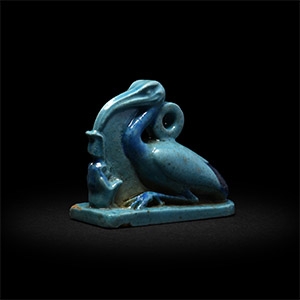



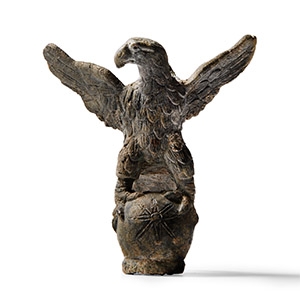
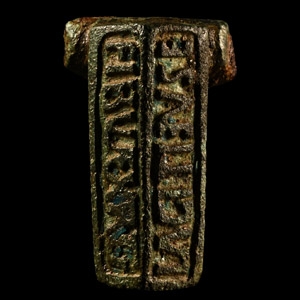

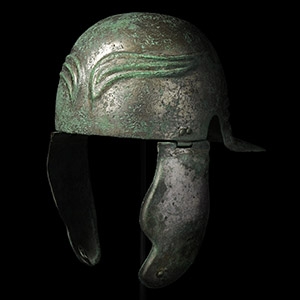
.jpg)
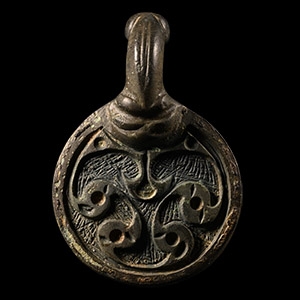
.jpg)
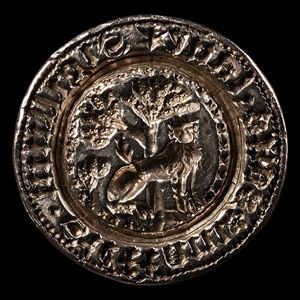
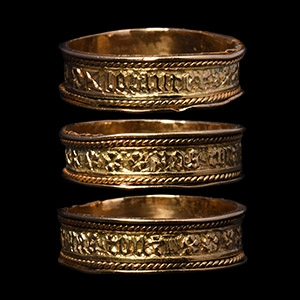



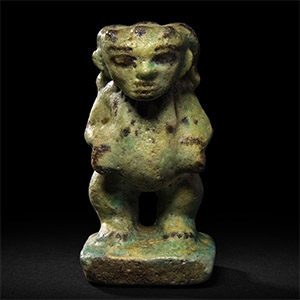
.jpg)
.jpg)
